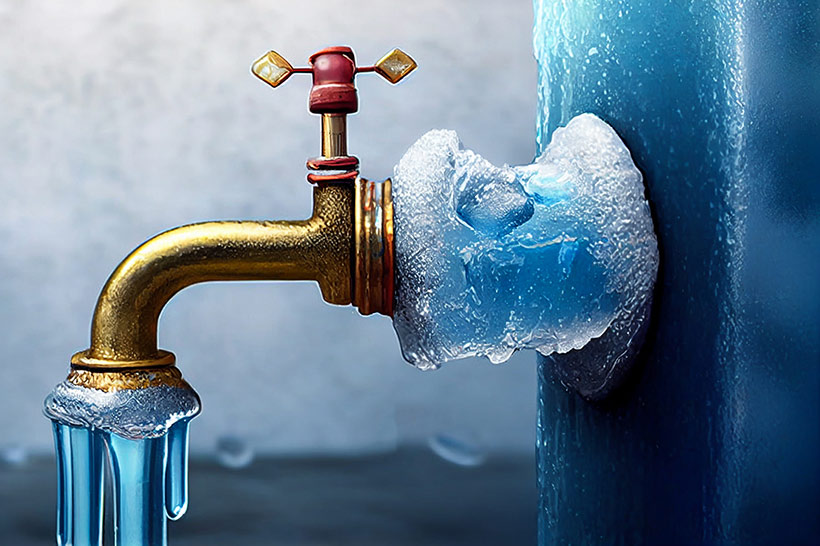Protecting Against Frozen Pipes in Winter: Key Tips
Protecting Against Frozen Pipes in Winter: Key Tips
Blog Article
They are making a number of great observations on the subject of Helpful Tips to Prevent Frozen Pipes this Winter in general in this great article down the page.

Cold weather can ruin your pipes, specifically by freezing pipelines. Right here's exactly how to avoid it from happening and what to do if it does.
Introduction
As temperature levels decline, the danger of icy pipelines boosts, potentially leading to pricey repair services and water damage. Understanding just how to avoid icy pipelines is critical for house owners in cool climates.
Avoidance Tips
Shielding susceptible pipelines
Cover pipes in insulation sleeves or utilize warmth tape to protect them from freezing temperatures. Concentrate on pipelines in unheated or exterior areas of the home.
Heating strategies
Maintain indoor rooms sufficiently heated up, especially locations with pipes. Open cupboard doors to enable warm air to circulate around pipes under sinks.
How to recognize icy pipelines
Try to find reduced water circulation from faucets, unusual odors or sounds from pipelines, and visible frost on exposed pipelines.
Long-Term Solutions
Architectural modifications
Consider rerouting pipes far from exterior walls or unheated areas. Include additional insulation to attic rooms, basements, and crawl spaces.
Upgrading insulation
Buy high-quality insulation for pipelines, attic rooms, and walls. Appropriate insulation aids maintain constant temperature levels and minimizes the risk of icy pipelines.
Safeguarding Outdoor Pipes
Garden hoses and exterior faucets
Separate and drain yard hose pipes prior to winter season. Mount frost-proof spigots or cover outside faucets with shielded caps.
Comprehending Icy Pipes
What triggers pipelines to ice up?
Pipes freeze when revealed to temperatures below 32 ° F (0 ° C) for prolonged periods. As water inside the pipes ices up, it increases, putting pressure on the pipeline wall surfaces and potentially causing them to burst.
Dangers and problems
Icy pipelines can bring about water supply disruptions, building damages, and pricey fixings. Ruptured pipelines can flood homes and cause extensive structural damages.
Indicators of Frozen Water Lines
Determining frozen pipelines early can stop them from rupturing.
What to Do If Your Pipes Freeze
Immediate activities to take
If you presume frozen pipelines, maintain faucets open up to eliminate pressure as the ice thaws. Utilize a hairdryer or towels taken in warm water to thaw pipes gradually.
Conclusion
Protecting against icy pipelines needs aggressive procedures and fast actions. By understanding the reasons, indications, and preventive measures, homeowners can protect their pipes during winter.
5 Ways to Prevent Frozen Pipes
Drain Outdoor Faucets and Disconnect Hoses
First, close the shut-off valve that controls the flow of water in the pipe to your outdoor faucet. Then, head outside to disconnect and drain your hose and open the outdoor faucet to allow the water to completely drain out of the line. Turn off the faucet when done. Finally, head back to the shut-off valve and drain the remaining water inside the pipe into a bucket or container. Additionally, if you have a home irrigation system, you should consider hiring an expert to clear the system of water each year.
Insulate Pipes
One of the best and most cost-effective methods for preventing frozen water pipes is to wrap your pipes with insulation. This is especially important for areas in your home that aren’t exposed to heat, such as an attic. We suggest using foam sleeves, which can typically be found at your local hardware store.
Keep Heat Running at 65
Your pipes are located inside your walls, and the temperature there is much colder than the rest of the house. To prevent your pipes from freezing, The Insurance Information Institute suggests that you keep your home heated to at least 65 degrees, even when traveling. You may want to invest in smart devices that can keep an eye on the temperature in your home while you’re away.
Leave Water Dripping
Moving water — even a small trickle — can prevent ice from forming inside your pipes. When freezing temps are imminent, start a drip of water from all faucets that serve exposed pipes. Leaving a few faucets running will also help relieve pressure inside the pipes and help prevent a rupture if the water inside freezes.
Open Cupboard Doors
Warm your kitchen and bathroom pipes by opening cupboards and vanities. You should also leave your interior doors ajar to help warm air circulate evenly throughout your home.

Hopefully you liked our piece on Preventing and dealing with frozen pipes. Thank you for spending some time to browse our piece. If you enjoyed our blog entry please consider to pass it around. We enjoy your readership.
Call Today Report this page